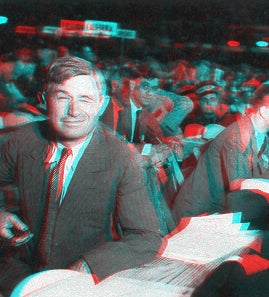Liner Notes from George Lewis Booklet
by Walter Lewis
George K. Lewis was the last of the generation of professional stereoscopic photographers who had for many years examined the world and brought into the parlor the popular pictorial travelogues of that day. George was born in Mesa, Arizona in 1902. His father was a farmer-rancher who homesteaded in that arid area in the 1890s and helped build the first irrigation canals. His mother was a teacher from a pioneer community of northeastern Arizona. After he had finished his public schooling, he was sent for two years at age 16 as a proselytizing missionary for his church into the states of Montana and Washington. Upon his return he enrolled at Brigham Young University, where his mother had graduated. He acquired from his mother her hobby and skill in photography, and with his natural artistic talent he became the activity photographer for the student body. A second hobby was raising two cougars (the school mascots) which had been captured as cubs in the Grand Canyon area and which he “handled” long after they reached maturity.
During his summer breaks, George was employed by the Union Pacific Railroad as a bus-driver and guide for the tourists to the parks of southern Utah and northern Arizona. In those days of rudimentary transportation, the Union Pacific would disgorge its weekly load of tourists at the dead-end terminal of Cedar City, Utah. There, due to the small, open-air buses, they would be assigned in groups of 12-15 to these young college drivers, who would be responsible for them for the week as they drove over primitive dirt roads through Zion, Grand Canyon, Bryce Canyon and Cedar Breaks. It was a rather arduous and sometimes terrifying experience for these eastern “dudes” to traverse high mountain passes, suffer physical stress because of mechanical breakdowns, and endure disconcerting feelings of isolation in the vast western wilderness. G.E. Hamilton, Vice President of Keystone View Company, was one of these “dudes” who became well acquainted with George during the week of “togetherness”, and hired him as a photographer for the company. (August, 1929) As a boy, his relatives called him George K. to differentiate him from his father George W. This name evolved (with the help of the pronunciation of George in Spanish as “Horkay”) to the nickname “Georkee” by which everyone knew him until his move to the job with Keystone.
George subsequently traveled to many areas of the world, adding thousands o views to the library of Keystone. One anecdote he enjoyed telling related to a photo appointment he had with Mahatma Ghandi. As Ghandi sat on the floor in his white robes, George, to break the ice, brought with him a Keystone Telebinocular viewer with pictures of dignitaries Ghandi might know, so he could see them in full three-dimensional reality. As Ghandi momentarily took the viewer from his eyes, but still holding it near his face while displaying a big smile, George snapped a picture. An aid of Ghandi’s, sensing possible commercial implications, immediately jumped up and protested that he couldn’t permit a picture like that to be taken. George, without hesitation, removed the film carrier from the 5x7 Stereo Graflex, slid open the back cover slide and handed the flow ruined film to the protesting aid. The aid, apparently unaware that there are two sides, and there- fore two films in a Graflex film carrier, was placated.
One of George’s assignments took him to Capetown, South Africa, from where he traversed that continent back and forth all the way to Egypt, where he arrived just in time to take his most famous stereograph. He climbed to the top of the Great Pyramid at Giza with all his equipment and took a picture of two men in native robes sitting in the foreground, looking across at the Graf Zeppelin flying over an adjacent pyramid. He included a golf club and ball with his equipment and had a helper snap a stereo as he drove off the tallest tee in the world. Keystone had contracted with writer Carl Sandburg to compose commentaries that were printed on the backs of the views. As Sandburg had not visited all the places where George had taken pictures, the two had to get together frequently to compare notes on what should be said with Sandburg’s language expertise. This association developed into a close friendship for many years.
In the 1930s George developed bone cancer and had a leg amputated. This forced him toward more sedentary activities. He became a principle in the Three Dimension Coin company of Chicago, where during World War II his artistic talent and understanding of 3-D combined in his creation of the “Cones of Fire” series for the Armed Services. This taught pilots how to approach enemy aircraft from an angle which would minimize expo-sure to fire. After the war his designs helped TDC. to become, at the time, the foremost slide projector manufacturer in the world. After TDC. was acquired by Bell & Howell in the early 1950s, George retired to his ranch in a remote canyon of southern Utah, contiguous to Zion National Park. He died in 1975.
From Stereo World
November/December 1993

